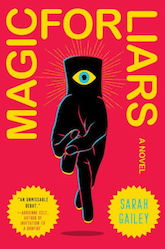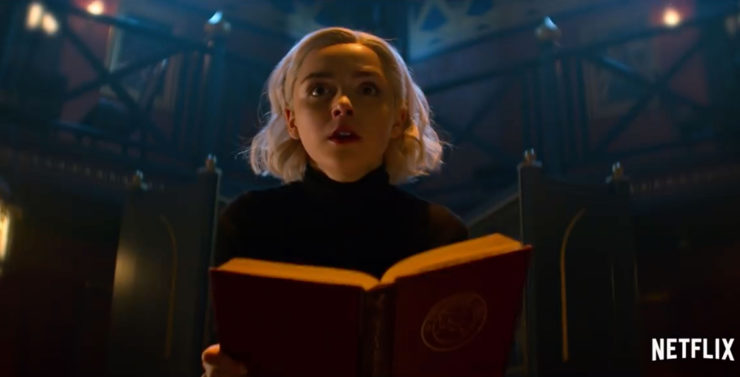An orphan, whose parents died in mysterious circumstances, is chosen to attend a secretive school. Perhaps it was destiny. Or maybe their skills were particularly well suited for what the school teaches. Maybe it was magic… Whatever the reason, they go to the school. What other option do they have? They’re an orphan! The school—whether it’s dedicated to training assassins, or witches, or just geniuses—is run by an evil headmaster who possibly has good intentions, but most likely is a nefarious character.
This broad plot overview represents a common trope in young adult literature—and it also describes not one, but three current television shows.
In Syfy’s Deadly Class, Marcus, an orphan (he’s also homeless), is recruited to attend King’s Dominion and taught how to be an assassin. In Netflix’s Carmen Sandiego, Carmen, the titular international woman of mystery, is brought up at V.I.L.E. (Villains’ International League of Evil) Academy and trained to be a thief; and in Netflix’s The Chilling Adventures of Sabrina, the titular heroine is grappling with the decision to leave her high school in order to study dark magic at The Academy of the Unseen Arts. These three seemingly unconnected shows all center on villain schools, where dark skills or some wicked behavior is taught (TV Tropes also calls this trope the “academy of evil”). One is an example, two is a coincidence, and three is a trend; it’s safe to say that villain schools are having a pop culture moment.
But why are “villain schools” having a moment? Perhaps it’s due to the rise in successful comic book adaptations, which began their ascendancy in 2008 with Iron Man. “People suddenly wanted escapism into a different world where the hero always triumphed and where distinctions between good and bad were easy to tell,” according to an article posted by New York Film Academy. “Comic-book superhero movies, in which the hero triumphs over evil, became more appealing to the general public.”
Yet, these shows specifically center on villainy and evil—evil that is not necessarily triumphing over good, but not losing, either. In Chilling Adventures, it takes the form of the witchy Madam Satan who runs the Academy for the Unseen Arts, and our protagonist Sabrina doesn’t necessarily triumph over her—she makes a deal with her. In Deadly Class, the protagonists are the children of powerful drug dealers and white supremacists, among others; the homework assignment in the first episode is literally to “find someone who deserves to die and kill them.” And in Carmen Sandiego, while Carmen is now “good,” the show still focuses on how her skills were learned and honed at the villain school she attended.
I’d argue, then, that the answer to understanding this pop culture moment does not lie with comic book adaptations and its focus on heroes, but instead with young adult literature.
The trope of villain schools appeals to young readers—and young audiences, in general—for two key reasons. One, the setting of the school makes the stories accessible and relatable: Even if you don’t happen to be an evil genius, you can understand having to deal with a teacher who gives too much homework. And two, despite attending villain schools, none of these protagonists are truly bad people. They’re super-smart, or have magical abilities, and they’re usually positioned as working against the school administration. Again: this is deeply relatable for young readers. What kid doesn’t think they know more than their parents? We see this in Carmen Sandiego and Chilling Adventures, as we root for a young protagonist who consistently outsmarts the adults around her. Really, it was only a matter of time before the newfound popularity of the villain school trope made the leap from YA to the small screen.
In Mark Walden’s young adult H.I.V.E. series (H.I.V.E. stands for the Higher Institute of Villainous Education; the villain school trope loves a good acronym), the protagonist is a 13-year-old orphan named Otto. Kidnapped to attend H.I.V.E., Otto begins to plot his escape immediately upon arrival. As readers, we instinctively root for Otto—he seems to be smarter than his professors and is clearly not meant to be a bad guy. Yet we still enjoy how he has to take classes in subjects like “Villainy Studies” and read textbooks titled A Beginner’s Guide to Doomsday Weapons. The plot is similar in Jeffery Salane’s middle-grade novel Lawless, where the heroine, M, attends Lawless Academy, a school for children of criminal masterminds. The tagline of the book is “the right school for kids on the wrong side of the law,” which sums up the “villain school” trope neatly. But M, even though she has been brought up to learn how to be a criminal —can you guess?—strives to do good.
Buy the Book


Magic for Liars
Cadel, the protagonist of Evil Genius by Catherine Jinks, is an orphan with a proclivity for hacking. When Cadel is seven, his adoptive parents bring him to Dr. Thaddeus Roth, a psychologist who turns out to be a criminal. Roth tells Cadel his real father is Phineas Darkkon, an evil genius. He encourages Cadel to follow in his supposed father’s footsteps—by attending a villain school, Axis Institute, where the electives include infiltration, misinformation, explosives, and lying, among others. Cadel, when he finds out about the school, calls it a “university of evil,” and is aghast at all the villainous behavior encouraged by the staff and teachers. And this initial doubt is what works so well about Jinks’ novel. By acting as a stand-in for the reader who would never attend a “university of evil”—a villain school—Cadel becomes a complicated protagonist we can root for unreservedly. He’s gifted with astonishing skills, but trying not to use them for evil ends.
Like Otto in the H.I.V.E. series and Cadel in the Evil Genius series, Carmen Sandiego is not inherently evil, even if the plot is structured around her committing crimes. Carmen, like the protagonists in other “villain school” stories, is simply a very smart kid trying to cope with her abilities without being a bad person. This balancing act—figuring out how to navigate a world that’s not good while remaining true to yourself—emerges often in young adult literature. In previous iterations of the franchise, the character of Carmen Sandiego was a criminal mastermind and international thief. But in the new animated series, whose target audience is primarily children in the 6-11 age range, Carmen becomes a good person in a villainous situation (her school), and attempts to make amends. Carmen Sandiego is clearly replicating the stories of villain schools in YA literature.
Oftentimes, these villain schools are not only for super-smart or super-skilled kids, but magical ones. Soman Chainani takes the villain school trope literally; in his book The School for Good and Evil, two children are kidnapped every four years and sent to the titular school, where they are trained to become either fairy-tale heroes or villains. The story focuses on two friends: Sophie, who thinks she belongs in the “Good” school but ends up at the “Evil” one, and Agatha, who wails, “Why am I going to villain school? Why has everyone elected me the Mistress of Evil?” but ends up in the “Good” one. Because of course the trope works just as effectively when the villain school isn’t just for teaching straight-up nefarious skills, but for teaching fantastical, mythological, and magical beings.
Thus, there exists a long YA literature tradition of the villain school for wizards and witches. In Anthony Horowitz’s Groosham Grange, published in 1988, 12-year-old David (not an orphan, gasp!) discovers he’s a wizard when he’s sent to Groosham Grange, a school of evil magic. David, like Sabrina in Chilling Adventures, tries to be good in this bad situation and strains against the authorities—all whilst learning skills to use against his teachers and figuring out his own magical talent. In J.K. Rowling’s Harry Potter and the Goblet of Fire, published in 2000, readers learn about Durmstrang, a wizarding school where its pupils are taught the dark arts. (At Hogwarts, the “good” wizarding school, pupils are taught defense against the dark arts.) As Rowling’s Pottermore explains, Durmstrang isn’t necessarily a villain school, but “has twice in its history fallen under the stewardship of wizards of dubious allegiance or nefarious intent, and that it has one infamous ex-pupil.” Headmasters with nefarious intent running schools teaching evil behavior… sounds familiar by now, right?
These books, from Groosham Grange to H.I.V.E., are teaching their young readers how to do the right thing, without resorting to scolding or moralizing. The authors put their protagonists in absurd situations—an evil boarding school on a volcanic island!—that remain fundamentally recognizable, because they’re at school, navigating many of the same issues as regular students. And this is where our current pop culture moment, if we can call it that, emerges from: by pushing the settings and situations to the extreme through the trope of villain schools, the protagonist’s choices become more complicated, even while their own sense of identity, beliefs, and desires are clarified in the process.
Which brings us back to Deadly Class, Chilling Adventures of Sabrina, and Carmen Sandiego. The protagonists of these three shows are all thrust into situations at villain schools where they must adjust and reorient their moral compasses, where their beliefs are challenged, and standing up for decency and ethical behavior is always a choice, if not an outright struggle. The basic, clear-cut comic book premise of good triumphing over obvious evil doesn’t apply to these shows; instead, the villain school young adult trope is fundamentally about the process of a maybe-good person figuring out who they are while working to get out of a bad, and certainly complicated, situation. I can certainly see how that would feel rather relatable—for young people, and maybe viewers of all ages—at this particular moment in time.
Emily Burack is a freelance writer based in New York. She can be found on her book blog and her website, but mainly on Twitter at @emburack










